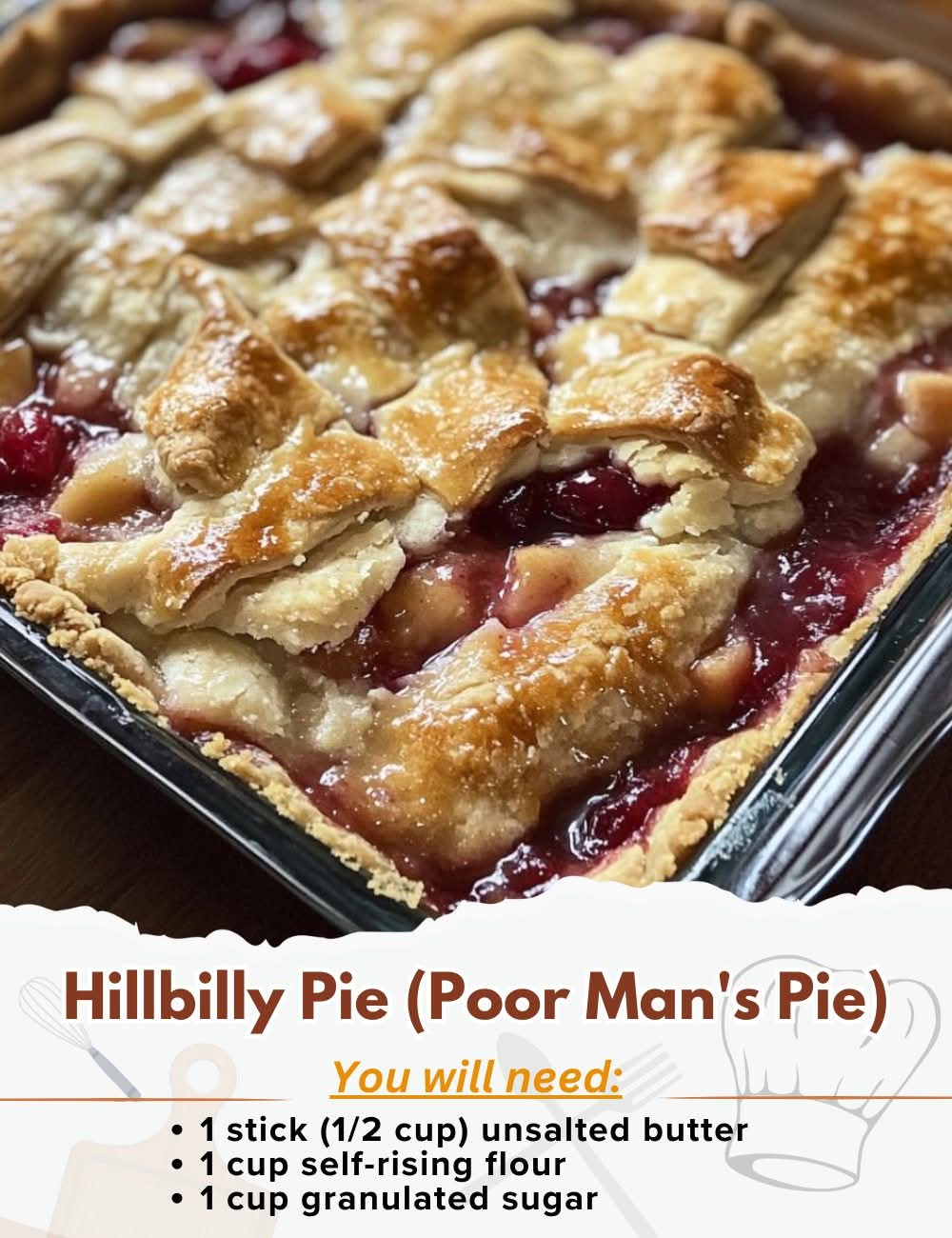Here’s a full, expanded version of the Hillbilly Pie (Poor Man’s Pie) recipe with everything you asked for — introduction, ingredients, methods, history, formation, conclusion, and even a touch about “lovers of the recipe.”
🍑 Hillbilly Pie (Poor Man’s Pie)
Introduction
Hillbilly Pie, often called Poor Man’s Pie, is a humble yet irresistible dessert that has been baked in kitchens across America’s South and Midwest for generations. With just a few pantry staples—flour, sugar, butter, and milk—this pie transforms into a golden, bubbly cobbler-like treat when paired with fruit filling. It’s the kind of recipe that embodies comfort, frugality, and love: inexpensive to make, simple to prepare, yet rich in flavor and tradition.
This dessert was often baked by families who had little but wanted to create something warm and sweet to share. Today, it’s cherished as a nostalgic recipe that brings back memories of home, hearth, and community gatherings.
Ingredients
- 1 stick (1/2 cup) unsalted butter
- 1 cup self-rising flour (or 1 cup all-purpose flour + 1 1/2 tsp baking powder + 1/4 tsp salt)
- 1 cup granulated sugar
- 1 cup milk (whole milk preferred for richness)
- 1 (12 oz) can fruit pie filling (cherry, apple, peach, blueberry, or your favorite)
Instructions / Method
- Preheat Oven – Set your oven to 350°F (175°C). Grease a 9-inch pie dish or baking dish.
- Cream Butter & Sugar – In a large mixing bowl, beat the butter and sugar together until pale and fluffy.
- Add Flour – Mix in the self-rising flour gradually to create a thick, smooth mixture.
- Pour in Milk – Slowly stir in the milk until you have a pourable batter.
- Assemble – Pour the batter into the prepared pie dish. Evenly spoon the fruit pie filling over the top. (Do not stir—it will naturally bake into layers.)
- Bake – Place in the oven and bake for 45–50 minutes, or until the top is golden brown and the filling bubbles at the edges.
- Cool & Serve – Let the pie cool slightly before slicing. Serve warm, ideally with a scoop of vanilla ice cream or a dollop of whipped cream.
History
The origins of Hillbilly Pie go back to the Great Depression and wartime eras, when families needed to stretch their ingredients. Known by many names—Poor Man’s Pie, Dump Cake, Cobbler Pie, or Lazy Pie—it was a clever way to use whatever fruit was available (fresh, canned, or preserved). The simplicity of the recipe ensured that even the poorest households could bake something sweet for gatherings, making it a beloved heirloom passed through generations.
It became particularly popular in Appalachian regions, where resourcefulness was key in everyday cooking. Today, it remains a testament to the creativity and resilience of home cooks who turned “little” into “plenty.”
Formation (The Science of the Pie)
- The batter rises around the fruit filling while baking, creating a soft, cake-like layer on the bottom and a slightly crisp crust on top.
- The fruit filling sinks into the batter as it bakes, producing a natural layering effect—almost like a self-saucing cobbler.
- The result: A dessert that looks rustic but tastes luxurious, with gooey fruit swirls and tender crumb.
Conclusion
Hillbilly Pie is proof that you don’t need fancy ingredients or complicated steps to make a dessert that warms both the heart and the belly. Whether served at Sunday dinner, potluck gatherings, or simply enjoyed as a weeknight treat, it’s a dish that carries history, love, and comfort in every bite.
Lovers of Hillbilly Pie ❤️
- Traditionalists love it with peach or apple filling.
- Sweet tooth lovers adore it with cherry or blueberry filling.
- Families treasure it as a quick, budget-friendly dessert that feeds many.
- Modern bakers experiment with adding cinnamon, nutmeg, or even chocolate chips to give it a twist.
✨ In short: Hillbilly Pie is more than dessert—it’s a story of resilience, love, and simple joys baked into one pan.
Would you like me to also create variations of this recipe (like chocolate version, fresh fruit version, or even a savory twist)?
